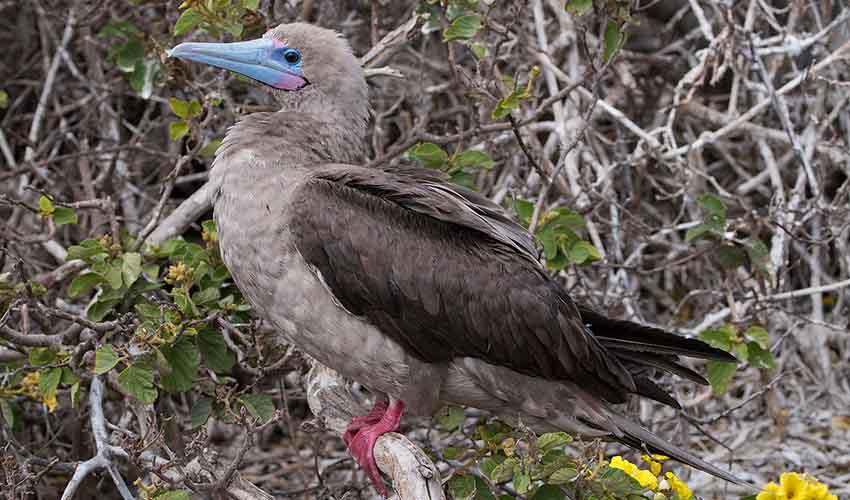One of the most colorful and agile seabirds in the world, and the smallest member of the booby family. What makes it instantly stand out — and gives it its name — are its bright red feet, which look like they’ve been dipped in paint. These eye-catching feet aren’t just for show; they play an important role during courtship displays, where males show them off with dramatic dances to impress females. Along with its vivid feet, this bird also has a blue beak and face, long pointed wings, and sleek feathers that come in a variety of colors — from pure white to grayish-brown. This makes the red-footed booby one of the few seabirds with multiple color morphs.
Unlike its larger relatives like the blue-footed and masked boobies, the red-footed booby is more lightweight and built for graceful, long-distance flying. Its slim body and long wings help it glide effortlessly over the ocean, often traveling hundreds of miles in search of food. They feed primarily on small fish and squid, which they catch by diving headfirst into the water from great heights. Watching one dive is like seeing a feathered torpedo in action — fast, precise, and powerful. They often hunt in groups and are known to follow schools of tuna or dolphins, which help drive fish closer to the surface.
One of the things that makes the red-footed booby unique among boobies is its nesting behavior. While other boobies nest on the ground, red-footed boobies are the only ones that nest in trees or shrubs, using twigs and branches to build a nest off the ground. They are found across tropical oceans, including the Caribbean, the Galápagos Islands, and the Pacific Islands, and often form large breeding colonies on remote islands where they can safely raise their young.
Distribution
 American Samoa
American Samoa Anguilla
Anguilla Antigua & Barbuda
Antigua & Barbuda Aruba
Aruba Australia
Australia Bahamas
Bahamas Bangladesh
Bangladesh Barbados
Barbados Belize
Belize Bonaire Sint Eustatius And Saba
Bonaire Sint Eustatius And Saba Brazil
Brazil British Indian T.
British Indian T. British Virgin Is.
British Virgin Is. Cayman Islands
Cayman Islands China
China Christmas Island
Christmas Island Cocos Is. (Keeling)
Cocos Is. (Keeling) Colombia
Colombia Comoros
Comoros Cook Islands
Cook Islands Costa Rica
Costa Rica Cuba
Cuba Curaçao
Curaçao Djibouti
Djibouti Dominica
Dominica Dominican Republic
Dominican Republic East Timor
East Timor Ecuador
Ecuador El Salvador
El Salvador Fiji
Fiji French Guiana
French Guiana French Polynesia
French Polynesia French Southern T.
French Southern T. Grenada
Grenada Guadeloupe
Guadeloupe Guam
Guam Guatemala
Guatemala Guyana
Guyana Haiti
Haiti Honduras
Honduras Hong Kong
Hong Kong India
India Indonesia
Indonesia Jamaica
Jamaica Japan
Japan Kenya
Kenya Kiribati
Kiribati Madagascar
Madagascar Malaysia
Malaysia Maldives
Maldives Marshall Islands
Marshall Islands Martinique
Martinique Mauritius
Mauritius Official estimate
Official estimate
 Mayotte
Mayotte Mexico
Mexico Micronesia
Micronesia Montserrat
Montserrat Mozambique
Mozambique Nauru
Nauru New Caledonia
New Caledonia Nicaragua
Nicaragua Niue
Niue Norfolk Island
Norfolk Island Nort. Mariana Is.
Nort. Mariana Is. Oman
Oman Palau
Palau Panama
Panama Papua New Guinea
Papua New Guinea Philippines
Philippines Pitcairn
Pitcairn Portugal
Portugal Puerto Rico
Puerto Rico Russia
Russia Réunion
Réunion Saint Helena
Saint Helena Saint Lucia
Saint Lucia Saint Martin
Saint Martin Saint Vincent
Saint Vincent Samoa
Samoa Seychelles
Seychelles Sint Maarten
Sint Maarten Solomon Islands
Solomon Islands Somalia
Somalia Sri Lanka
Sri Lanka St. Kitts & Nevis
St. Kitts & Nevis Suriname
Suriname Taiwan
Taiwan Tanzania
Tanzania Thailand
Thailand Tokelau
Tokelau Tonga
Tonga Trinidad & Tobago
Trinidad & Tobago Turks & Caicos
Turks & Caicos Tuvalu
Tuvalu UAE
UAE US Minor Is.
US Minor Is. US Virgin Islands
US Virgin Islands United States
United States Vanuatu
Vanuatu Venezuela
Venezuela Vietnam
Vietnam Wallis & Futuna
Wallis & FutunaAnything we've missed?
Help us improve this page by suggesting edits. Glory never dies!
Suggest an editGet to know me
Terrestrial / Aquatic
Altricial / Precocial
Polygamous / Monogamous
Dimorphic / Monomorphic (size)
Active: Diurnal / Nocturnal
Social behavior: Solitary / Pack / Flock
Diet: Carnivore / Herbivore / Omnivore / Piscivorous / Insectivore
Migratory: Yes / No
Domesticated: Yes / No
Dangerous: Yes / No




